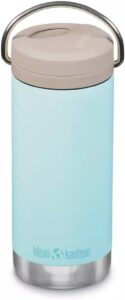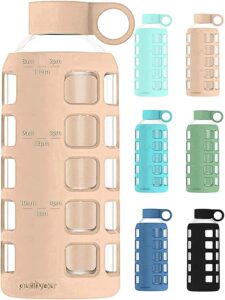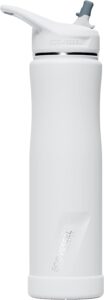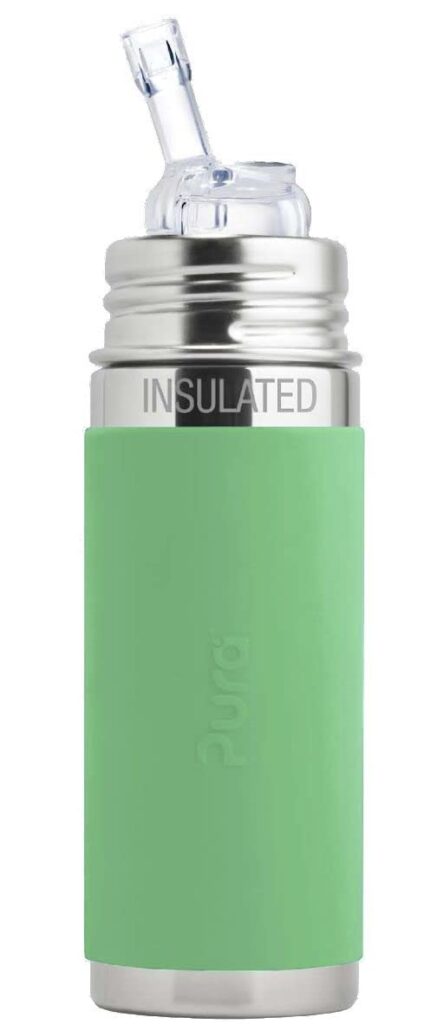
Obviously there are so many differences in the world now for my kids growing up compared to when I grew up. We know so much more about how to take care of our bodies and how to prevent disease rather than dealing with it when we’re older. One of the big things I notice as a parent is just how frequently my kids are toting around a water bottle. I can say I jumped on this trend too, years ago. Anytime I get in the car, my water bottle is with me.
And the reason is that water is just SO important to our health. I mean, the current recommendation is to drink half to all your weight in ounces of water every day. And consuming something THAT much, means we need to make sure it is properly filtered water as well as water that is being held in a toxin free space.
So after you filter your water to reduce all the dangerous contaminants, take a look at your water bottles. I know even for me, plastic water bottles keep sneaking into my cabinet from athletic programs, freebies that my kids grab and school. But there are so many better options compared to plastic… EVEN BPA free plastic. Here’s everything you need to know.
STUDIES THAT SHOW WATER BOTTLES MATTER TO YOUR HEALTH
The basis for everything I share with you is essentially to improve your health by improving the health of your home. And what studies have found is that reusable plastic bottles release hundreds of chemicals into the water it holds.
Plastic Toxins: Endocrine disrupting chemicals, and ultimately increase the risk of cancer are the BIG plastic toxins found in water bottles. A study also found that the active component in mosquito spray, DEET, was present. The longer water sat in the water bottle, the more toxins were present in the water. (STUDY) And even though BPA may not be found in most plastic water bottles anymore, phthalates have been found, which disrupt the endocrine system’s production of estrogen. Bisphenols are also still used, which have been linked to breast cancer and are suspected to be carcinogenic in nature.
Toxins from Soaps: A study done by the University of Copenhagen showed that even the residue from soaps and detergents and rinse aids are becoming practically embedded into the plastic. Even after five rinses with tap water, there were still components from the soaps and detergents. And while we can use low toxin detergents and soaps, it’s still not meant to be consumed by our bodies. (STUDY) The combination of plastic and the dishwasher definitely don’t mix as the heat increases the amount of toxins that can be leached into the water in the future.

WHY BPA FREE ISN’T REALLY TOXIN FREE
Over 90% of individuals in the United States carry bisphenol in their bodies. What’s alarming is that our bodies actually break down and remove bisphenol within just a few days. The fact that there are measurable amounts within MOST humans in the US means we are taking bisphenol in as fast as our bodies can get rid of it. (STUDY)
Bisphenol A has been shown to alter hormone production in the brain. It is known as an endocrine-active chemical. It also alters the cell and tissues receiving the hormones as it works mimicking estrogen. (STUDY) It was also recently linked to an increased risk of childhood asthma when children were exposed to the chemical at an early age or in utero. (STUDY)
Another study from 2018 compared concentrations of BPA, BPB, BPF and BPF in rats and it’s negative effects on the reproductive system. The study suggests that ALL forms of bisphenol are toxic and reduce the amount of testosterone produced in males. (STUDY) Bisphenol B also chronic reproductive problems and cessation in another study done on fish and aquatic life (STUDY).
Bisphenol S, which has been replacing BPA in a number of items, has been shown to leach into water and food with several negative health effects. A study from February of 2020 shows that although BPS works through different pathways than BPA, it still causes the equivalent health effects of endocrine disruption, gestational diabetes and metabolic disorders. The study also showed that BPS was actually MORE toxic to the reproductive system as well as linked it to the promotion of certain breast cancers. (STUDY)
Bisphenol F is found in much lower quantities around the United States, however it still has health effects that are similar to BPA. BPF is metabolized rapidly, and while it does not stay in the body for long, the fact that it is present in our bodies shows that we are being constantly exposed. BPF mimics estrogenic activity and has been linked to obesity. (STUDY)

SAFE WATER BOTTLE MATERIALS
And honestly, there are SO many relatively low cost options for replacing those plastic water bottles. Here’s what you should look for:
Glass is a great option for a water bottle and oftentimes they’re wrapped in silicone, which is a low toxin option as well. They can be a little on the heavy side, but they really clean up beautifully. They also generally don’t have any sort of added enamel on the outside, which can sometimes contain toxins. Glass is a tried and true toxin free option for water bottles.
Stainless Steel is another option that is quite common and perfect for kids and adults alike. It’s resilient to being dropped and so most of us trust our kids with it at school too. You can look for surgical stainless steel or a 304 stainless steel. These are both resilient to rust and corrosion of any kind. If you’re sensitive to nickel, you can purchase a 403 stainless steel, which does not contain nickel.

COMPONENTS OF A WATER BOTTLE THAT ARE IMPORTANT TO BE TOXIN FREE
Straws: Most water bottles typically have plastic straws. I don’t love this option for the obvious reason: it’s plastic. But it also sits in the water you’re about to drink and your water touches a large surface area of the straw before you consume it. This means plasti toxins can be leaching into the water as you’re drinking it. If you can find either a silicone straw or a stainless steel straw that will work, I would opt for that. Or find a water bottle that doesn’t have a straw at all.
Spouts: I like to see a medical grade or food grade silicone for the spout as opposed to a plastic. Remember, you’ll be putting your mouth on this spout to drink water, so it should be made of a material that is as low toxin as possible. While silicone isn’t completely toxin free, it is less toxic than plastic in this application.
Lids: This can be a bit of a gray area. If you’ll be drinking with your mouth touching the lid through either an opening or pour spout, it might be worth it to consider a less toxic option, although it can be difficult to find. Generally, the least toxic option is where the lid exposes part of the metal or glass in order to allow your mouth to drink from the actual water bottle material rather than plastic.
Exterior: Some stainless steel water bottles may have a differing exterior that can potentially contain toxins like heavy metals in order to adhere the enamel to the stainless steel. Of course, not all water bottles are made this way, so do your research ahead of time if you’re getting a water bottle with a colored exterior.

HEALTHY HOUSE APPROVED WATER BOTTLES
Klean Kanteen TK Wide Mouth: You can even get a compatible stainless steel straw. Made from 18/8 stainless steel and a powder coat finish free from toxins.
Purifyou: Glass water bottles with silicone covering and a simple design that allows you to drink water directly from the glass materials.
EcoVessel: I love the silicone spout and straw with a stainless steel inner and outer layer. It’s a beautiful design and perfect for on the go. Also in kids’ sizes
Pura Kiki: A great option for kids as it’s 100% plastic free. The medical grade silicone is used for the straw and spout as well as the exterior. The interior is 3054 stainless steel .
When you get the chance to overhaul your water bottles, make sure you are swapping them out with the BEST option (so you never have to think about it again!)







Great research, Amanda! What about Yeti’s and Stanley’s? I like them because they don’t sweat if cold water is in them.
HI Michele! Great question! Unfortunately, there have been a few instances where lead has actually been found in the solder on the bottom of the Stanley cups 🙁 So I don’t love those — but I do like the Yeti option!
Pingback: Household Neurotoxins You can Easily Remove From Your Home